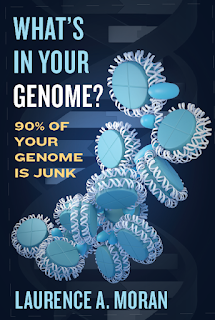There's something called "the EDIT lab blog" written by people at King's College In London (UK). Here's a recent post (May 19, 2023) that was apparently written by a Ph.D. student: J for Junk DNA Does Not Exist!.
It begins with the standard false history,
The discovery of the structure of DNA by James Watson and Francis Crick in 1953 was a milestone in the field of biology, marking a turning point in the history of genetics (Watson & Crick, 1953). Subsequent advances in molecular biology revealed that out of the 3 billion base pairs of human DNA, only around 2% codes for proteins; many scientists argued that the other 98% seemed like pointless bloat of genetic material and genomic dead-ends referred to as non-coding DNA, or junk DNA – a term you’ve probably come across (Ohno, 1972).
You all know what's coming next. The discovery of function in non-coding DNA overthrew the concept of junk DNA and ENCODE played a big role in this revolution. The post ends with,
Nowadays, researchers are less likely to describe any non-coding sequences as junk because there are multiple other and more accurate ways of labelling them. The discussion over non-coding DNA’s function is not over, and it will be long before we understand our whole genome. For many researchers, the field’s best way ahead is keeping an open mind when evaluating the functional consequences of non-coding DNA and RNA, and not to make assumptions about their biological importance.
As Sandwalk readers know, there was never a time when knowledgeable scientists said that all non-coding DNA was junk. They always knew that there was functional DNA outside of coding regions. Real open-minded scientists are able to distinguish between junk DNA and non-coding DNA and they are able to evaluate the evidence for junk DNA without dismissing it based on a misunderstanding of the history of the subject.
The question is why would a Ph.D. student who makes the effort to write a blog post on junk DNA not take the time to read up on the subject and learn the proper definition of junk and the actual evidence? Why would their supervisors and other members of the lab not know that this post is wrong?








